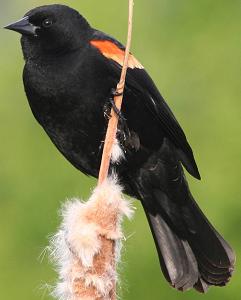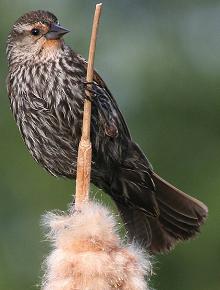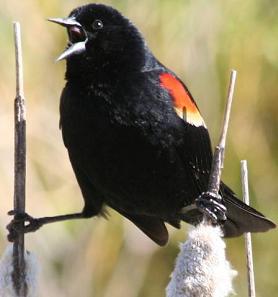Red-Winged Blackbird 
Identification and Pictures
(Agelaius phoeiniceus)
Red-winged blackbirds are a nearly all black bird, about 7
1/2 to 9 inches. They get their name from the distinctive red or orange-red shoulder
patch also called epaulets on the male. The red shoulder patch can be seen when in flight, but when they are at rest often
only the yellow margin can be seen. The birds have black, sharp,
cone-shaped beaks, and pointed wings, and their tails are rounded. Males can often be seen sitting
on high perches with tails slightly flared.
Immature males have the red patch but they are mottled brown.
brown.
The much smaller female Red-Wing blackbirds have brown plumage,
with dark streaking below, and often have a pink tinge on their throat.
They tend to stay lower in the vegetation so they are less
visible than the males.
Photos by Keith Lee. The camera I use is
the Canon EOS
40D and a 70 to 300 zoom lens. Visit All-birds store

Songs and Calls
Perching on top of a cattail with a spread tail, and displaying his red shoulder patches, the male sings
oak-a-leeee. He is quick to voice his disapproval of all intruders, and will often attack anything that enters his
territory including humans.
He will call out check-check-check, and a high trilled teer-errr
to warn off other birds.Red
Winged blackbird sound
Red
Winged blackbird sound 2
Range and Habitat
The Red-winged blackbird can be found across the entire continental United States.
In summer they extend
across Canada. Any place they can find food, and water, they will spend the winter.
Many will migrate south to the southern United States, and Mexico.
In winter Red-winged blackbirds gather in
large flocks to eat grains with other blackbird species, and starlings.
These huge flocks are incredible to see as they roll in waves
across the sky.
They inhabit freshwater and saltwater wetlands, and marshes, brushy swamps, meadows, fields, and prairies.
Breeding and Nesting
Breeding in colonies, males vigorously defend territories where a male may have as many as 10 females he breeds with.
Groups of males do rapid chases of females, returning to
their own territories afterwards. The females
will also breed with other males, and may have clutches with eggs from more than one male.
A pair may have 2 to 3 broods per
season. The eggs, and young have many predators such as snakes, raccoons, and other birds.
Group nesting
helps in protecting nests from the many predators. In defending their territories several birds will often mob
intruders. This is especially true of males. It is common for Brown-headed
cowbirds to lay their eggs in the nest of Red-winged blackbirds.
Females will build a deep cup shaped nest of grass, leaves, and moss, lined with mud.
She will
attach the nest to reeds, and branches.
The female will incubate a clutch of 3 to 5 pale blue eggs for around 12 days.
The eggs
are blotched with dark brown or purple spots, and sometimes have a pink tinge to them.
Both parents will feed the young birds will leave the nest in about 10 days. around 12 days.
The eggs
are blotched with dark brown or purple spots, and sometimes have a pink tinge to them.
Both parents will feed the young birds will leave the nest in about 10 days.
At the end of breeding season Red-winged blackbirds gather in huge flocks, often with other types of blackbirds.
These flocks sometimes number in the
thousands.
Food
Red-winged blackbirds feed mainly on seeds, and grains, but
also eats insects, spiders, aquatic life, and small animals.
They will visit back yard feeders for seeds and suet.
For more on food
and feeding click here.
For more on feeders click here.
Learn about other favorite
backyard birds.

|
